Wide Image: Mythology

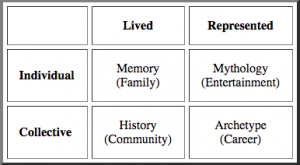 Structuralism: Claude Lévi-Strauss. Following the rule of heuretics curriculum, to treat one’s own materials as belonging to the disciplinary tradition, I applied Lévi-Strauss’s insights into the formal design of mythologies to my wide image. The wide mage in fact is a personal mythology, not only metaphorically but formally. Lévi-Strauss showed that individual instances of a myth manifest a system of relationships, covering all possible variations on the aporia (disaster in our terms) addressed by the myth. The system of relationships is that of proportional analogy (A is to B as C is to D), the figure of hypotyposis encountered throughout the tradition. The practice of myth-work applied to a mystory set (including the Career register documented, along with Family, Entertainment, Community) is to determine which stories/scenes are related in this proportional ratio, along what axes? In my case I found Family and Career related on an axis of space (The Sand and Gravel Plant scene, materializing the Choral metaphor of Plato and Derrida); Entertainment and History related on an axis of time. High Noon plays out almost in real time, intercutting between the clock in the sheriff’s office and the gunmen waiting for their boss to arrive on the noon train, while the sheriff tries to form a posse to fight them. Custer took his Seventh Cavalry far ahead of the rest of the advancing army, hoping to strike a quick blow against the Indians, to get the glory for himself, to propel him into candidacy for President of the United States in the 1876 election.. The symmetries formed in the crossings of this four-fold are provocative, suggestive of a diagram capable of translation into an original hypothesis for konsult.
Structuralism: Claude Lévi-Strauss. Following the rule of heuretics curriculum, to treat one’s own materials as belonging to the disciplinary tradition, I applied Lévi-Strauss’s insights into the formal design of mythologies to my wide image. The wide mage in fact is a personal mythology, not only metaphorically but formally. Lévi-Strauss showed that individual instances of a myth manifest a system of relationships, covering all possible variations on the aporia (disaster in our terms) addressed by the myth. The system of relationships is that of proportional analogy (A is to B as C is to D), the figure of hypotyposis encountered throughout the tradition. The practice of myth-work applied to a mystory set (including the Career register documented, along with Family, Entertainment, Community) is to determine which stories/scenes are related in this proportional ratio, along what axes? In my case I found Family and Career related on an axis of space (The Sand and Gravel Plant scene, materializing the Choral metaphor of Plato and Derrida); Entertainment and History related on an axis of time. High Noon plays out almost in real time, intercutting between the clock in the sheriff’s office and the gunmen waiting for their boss to arrive on the noon train, while the sheriff tries to form a posse to fight them. Custer took his Seventh Cavalry far ahead of the rest of the advancing army, hoping to strike a quick blow against the Indians, to get the glory for himself, to propel him into candidacy for President of the United States in the 1876 election.. The symmetries formed in the crossings of this four-fold are provocative, suggestive of a diagram capable of translation into an original hypothesis for konsult.
–Noon Star Diagram
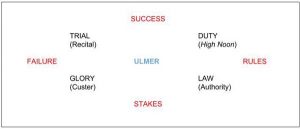

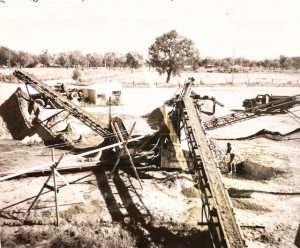 Wide Image into Diagram. The next step after using the emblem catechism to generate wide image is to begin translation into diagrams, extracting patterns from the intervals and relationships emerging within the matrix. Composing my first mystory in the mid-1980s, “Derrida at the Little Bighorn,” I discovered a match between Family and Career that produced an epiphany I have developed ever since. One of my first jobs when I worked at the plant was to clean the grids of the screens used to grade the gravel into sizes. Eventually the screens plugged up with stones and I had to knock them loose with a hammer. The pea-gravel screen could be cleaned by running the tip of a large screwdriver along the meshed grids, which produced an almost musical sound. This was the actual “gravel plant.” The washer with its three grades of screen, one on top of the other, was fed by a conveyor belt carrying the pit gravel from the quarry, and fed in turn three piles of sized rock, with the sand coming out the bottom. The whole contraption made a terrible noise and shook violently. I realized years later, reading Plato’s Timaeus after Derrida, that this gravel washer was a good metaphor or model for the operation of chora, sorting chaos into Earth, Air, Fire, Water.
Wide Image into Diagram. The next step after using the emblem catechism to generate wide image is to begin translation into diagrams, extracting patterns from the intervals and relationships emerging within the matrix. Composing my first mystory in the mid-1980s, “Derrida at the Little Bighorn,” I discovered a match between Family and Career that produced an epiphany I have developed ever since. One of my first jobs when I worked at the plant was to clean the grids of the screens used to grade the gravel into sizes. Eventually the screens plugged up with stones and I had to knock them loose with a hammer. The pea-gravel screen could be cleaned by running the tip of a large screwdriver along the meshed grids, which produced an almost musical sound. This was the actual “gravel plant.” The washer with its three grades of screen, one on top of the other, was fed by a conveyor belt carrying the pit gravel from the quarry, and fed in turn three piles of sized rock, with the sand coming out the bottom. The whole contraption made a terrible noise and shook violently. I realized years later, reading Plato’s Timaeus after Derrida, that this gravel washer was a good metaphor or model for the operation of chora, sorting chaos into Earth, Air, Fire, Water.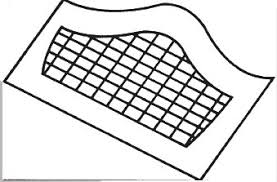 –Derrida, Chora-L As part of his collaboration with the architect, Peter Eisenman, on a design for one of the folies, to be included in the Park for Creativity, Parc de la Villette, in Paris, Derrida produced a drawing and a descriptive concept for an impossible project: to build Chora. “I propose therefore the following ‘materialisation’: in one or three exemplars (with different scalings) a gilded metallic object will be planted obliquely in the ground. Neither vertical nor horizontal, a most solid frame will resemble at once a mesh, sieve, or grid and a stringed musical instrument. An interpretive and selective filter which will have permitted a reading and sifting of the three sites [at the Park] and the three embeddings.”
–Derrida, Chora-L As part of his collaboration with the architect, Peter Eisenman, on a design for one of the folies, to be included in the Park for Creativity, Parc de la Villette, in Paris, Derrida produced a drawing and a descriptive concept for an impossible project: to build Chora. “I propose therefore the following ‘materialisation’: in one or three exemplars (with different scalings) a gilded metallic object will be planted obliquely in the ground. Neither vertical nor horizontal, a most solid frame will resemble at once a mesh, sieve, or grid and a stringed musical instrument. An interpretive and selective filter which will have permitted a reading and sifting of the three sites [at the Park] and the three embeddings.”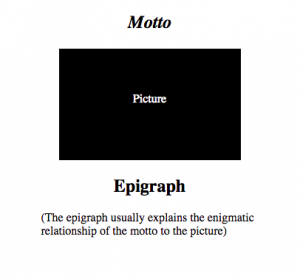 Catechism: Wide Image. The catechism of modernism (drawing on the Western Tradition) is articulated in Kant’s philosophy and Gauguin’s painting. The answers to the questions are specific to each person, and are generated during the composition of the wide image. Several posts are required to unfold this poetics, by means of which egents learn to actualize in their own projects the intelligence potential (latent) in the cultural archive. This archive in its global version functions for electracy the way Avatar functioned for orality: source of absolute knowledge (the project of Avatar Emergency was learning to receive this communication of Avatar). One of the first things that happens in transition from one apparatus to another is the mise en machine of the previous apparatus. As McLuhan observed, the content of the new medium is the old medium (literacy put oral mythologies into writing; electracy digitized the libraries). The remainder of the apparatus epoch is devoted to invention and diffusion throughout society of the new metaphysics (operating practices).
Catechism: Wide Image. The catechism of modernism (drawing on the Western Tradition) is articulated in Kant’s philosophy and Gauguin’s painting. The answers to the questions are specific to each person, and are generated during the composition of the wide image. Several posts are required to unfold this poetics, by means of which egents learn to actualize in their own projects the intelligence potential (latent) in the cultural archive. This archive in its global version functions for electracy the way Avatar functioned for orality: source of absolute knowledge (the project of Avatar Emergency was learning to receive this communication of Avatar). One of the first things that happens in transition from one apparatus to another is the mise en machine of the previous apparatus. As McLuhan observed, the content of the new medium is the old medium (literacy put oral mythologies into writing; electracy digitized the libraries). The remainder of the apparatus epoch is devoted to invention and diffusion throughout society of the new metaphysics (operating practices).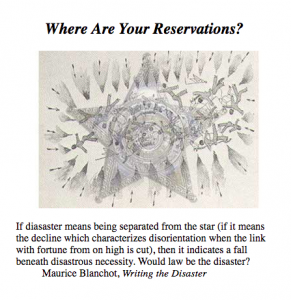 –Emblem. The translation of mystory into wide image is mediated by emblematics. The emblem (having the same structure as a generic advertisement), considering its historical relationship with allegory, expresses in condensed form the image of wide scope ( sinthome, Lacan) that emerges in the making of a mystory (it embodies the pattern of signifiers that repeat when the makers situation is mapped across the popcycle). Studio and Textshop exercises explore the form, including its history from its introduction in the Renaissance through to contemporary advertising. An advantage of the form is just this combination of archival presence and pop familiarity. Ulmer designed this emblem based on his mystory: Motto is “pithy,” aphoristic, allusive, to produce an evocative connotation when combined with the picture. The epigraph is informational, clarifying what is suggested in the motto-picture juxtaposition.
–Emblem. The translation of mystory into wide image is mediated by emblematics. The emblem (having the same structure as a generic advertisement), considering its historical relationship with allegory, expresses in condensed form the image of wide scope ( sinthome, Lacan) that emerges in the making of a mystory (it embodies the pattern of signifiers that repeat when the makers situation is mapped across the popcycle). Studio and Textshop exercises explore the form, including its history from its introduction in the Renaissance through to contemporary advertising. An advantage of the form is just this combination of archival presence and pop familiarity. Ulmer designed this emblem based on his mystory: Motto is “pithy,” aphoristic, allusive, to produce an evocative connotation when combined with the picture. The epigraph is informational, clarifying what is suggested in the motto-picture juxtaposition.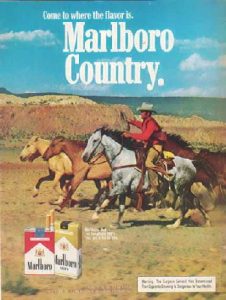 –Advertisement.The Marlboro Cowboy
–Advertisement.The Marlboro Cowboy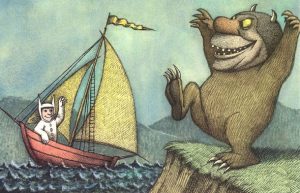 Maurice Sendak is best known for his Caldecott Medal winning illustrated children’s book, Where the Wild Things Are (1963), made into
Maurice Sendak is best known for his Caldecott Medal winning illustrated children’s book, Where the Wild Things Are (1963), made into 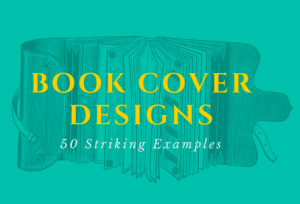 –Family (Personal): Composition of mystory usually begins with a memory from early childhood, life with the family. Up to three such memories are allowed, to avoid getting stuck deciding on one that is most important (that dilemma if it arises is resolved when the remaining slots are filled, following the rule what resembles assembles). Sendak proposed two memories: the first was one of his earliest, an encounter with one of the pedagogical objects Pasolini mentioned, a book his older sister received from her book club. The book was very thick with a hardcover of pale green with gold lettering. Although not yet able to read, Sendak was fascinated with the book and demanded to have it, creating so much commotion the parents made his sister give it to him. When he finally returned it to his sister it was in bad shape, including suffering from being licked all over.
–Family (Personal): Composition of mystory usually begins with a memory from early childhood, life with the family. Up to three such memories are allowed, to avoid getting stuck deciding on one that is most important (that dilemma if it arises is resolved when the remaining slots are filled, following the rule what resembles assembles). Sendak proposed two memories: the first was one of his earliest, an encounter with one of the pedagogical objects Pasolini mentioned, a book his older sister received from her book club. The book was very thick with a hardcover of pale green with gold lettering. Although not yet able to read, Sendak was fascinated with the book and demanded to have it, creating so much commotion the parents made his sister give it to him. When he finally returned it to his sister it was in bad shape, including suffering from being licked all over. I was eleven when I saw the movie, and I remember it vividly because of how intensely in frightened me. The moment I am talking about is the one when Dorothy is trapped by the Wicked Witch of the West, and the witch takes an hourglass and turns it over and says something horrible like, “When the sand runs out, you’re dead, honey.” Judy Garland is left alone in the room, and one of her best moments ever was her way of saying, “I’m frightened,” and then, as though that realization has just actually dawned on her, says it a second time, “I’m frightened.” I still remember how her hand went to her head–the way she had of fluttering her hand, her desperation was so convincing. There was no way out of that room, nothing she could do. And suddenly, in the witch’s crystal ball, she sees her Auntie Em, back in Kansas, standing in the yard and calling to her. And she rushes to the crystal ball, and stands over it and screams, “Auntie Em! Here I am!”
I was eleven when I saw the movie, and I remember it vividly because of how intensely in frightened me. The moment I am talking about is the one when Dorothy is trapped by the Wicked Witch of the West, and the witch takes an hourglass and turns it over and says something horrible like, “When the sand runs out, you’re dead, honey.” Judy Garland is left alone in the room, and one of her best moments ever was her way of saying, “I’m frightened,” and then, as though that realization has just actually dawned on her, says it a second time, “I’m frightened.” I still remember how her hand went to her head–the way she had of fluttering her hand, her desperation was so convincing. There was no way out of that room, nothing she could do. And suddenly, in the witch’s crystal ball, she sees her Auntie Em, back in Kansas, standing in the yard and calling to her. And she rushes to the crystal ball, and stands over it and screams, “Auntie Em! Here I am!” The major event of my childhood was the kidnapping of the Lindbergh baby in 1932. That nightmare was probably the origin of my conviction that children can’t be shielded from frightening truths. Although I was only three, I remember intensely the details of the Lindbergh case. Lindbergh was our Prince Charles, and his wife was our Princess Di. I particularly remember a newspaper that had the front-page headline LINDBERGH BABY FOUND DEAD and a photograph of a scene in the woods with a black arrow pointing to something awful. I’ve since learned that Colonel Lindbergh threatened to sue if the New York Daily News didn’t have the morning edition pulled off the newsstands, so I guess not many people saw the picture. But I saw the picture.
The major event of my childhood was the kidnapping of the Lindbergh baby in 1932. That nightmare was probably the origin of my conviction that children can’t be shielded from frightening truths. Although I was only three, I remember intensely the details of the Lindbergh case. Lindbergh was our Prince Charles, and his wife was our Princess Di. I particularly remember a newspaper that had the front-page headline LINDBERGH BABY FOUND DEAD and a photograph of a scene in the woods with a black arrow pointing to something awful. I’ve since learned that Colonel Lindbergh threatened to sue if the New York Daily News didn’t have the morning edition pulled off the newsstands, so I guess not many people saw the picture. But I saw the picture.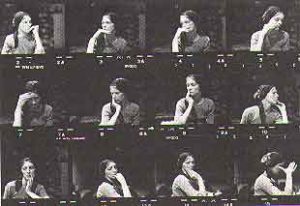
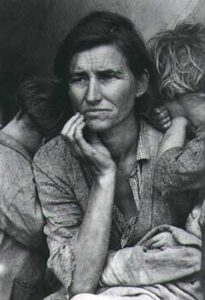 Nancy Kitchel’s “grandmother’s gesture” may be seen as a series of variations on a gesture of worry and anxiety codified in this photograph taken by Dorothea Lange as part of a New Deal project to document the misery of migrant workers, sponsored by the Farm Security Administration during the Great Depression. “Migrant Mother” is one of the most-cited pictorial images of our times.
Nancy Kitchel’s “grandmother’s gesture” may be seen as a series of variations on a gesture of worry and anxiety codified in this photograph taken by Dorothea Lange as part of a New Deal project to document the misery of migrant workers, sponsored by the Farm Security Administration during the Great Depression. “Migrant Mother” is one of the most-cited pictorial images of our times.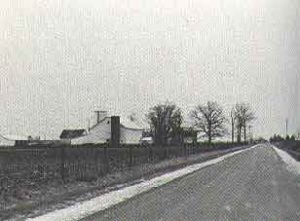 This idea I have that the whole inside of my head resembles this landscape (flat? nothing there?), that the particular, peculiar sense of great space, isolation in space, harshness, clarity, severity, the constant transitions, shifts, reveries, the wild swings form one state to another, forms the visual, auditory, reasoning, base for thought or action. A sense that I have been formed out of the quality of the landscape, that everything unnecessary is being slowly eroded by harsher elements. And the confidence that I will survive, denuded, or that something will survive, something will never stop.”
This idea I have that the whole inside of my head resembles this landscape (flat? nothing there?), that the particular, peculiar sense of great space, isolation in space, harshness, clarity, severity, the constant transitions, shifts, reveries, the wild swings form one state to another, forms the visual, auditory, reasoning, base for thought or action. A sense that I have been formed out of the quality of the landscape, that everything unnecessary is being slowly eroded by harsher elements. And the confidence that I will survive, denuded, or that something will survive, something will never stop.” 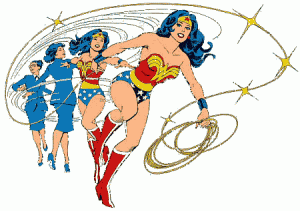 Wonder Woman
Wonder Woman

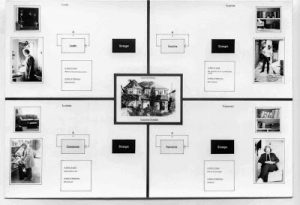 When it comes to the image of wide scope (four or five fundamental images structuring imagination, and central to the history of invention), the prototype is Einstein’s compass (received from his father as a gift at age four or five): the wide image is a compass for the existential positioning system of learning, to orient egents tracking the vector of invention.
When it comes to the image of wide scope (four or five fundamental images structuring imagination, and central to the history of invention), the prototype is Einstein’s compass (received from his father as a gift at age four or five): the wide image is a compass for the existential positioning system of learning, to orient egents tracking the vector of invention.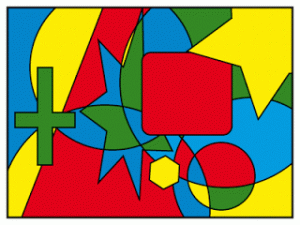 Popcycle. Learning is a complex adaptive system, and an aspect of what we are exploring is a certain isomorphism transversing all such systems. Heuretic pedagogy is describable within a systems perspective, beginning with the
Popcycle. Learning is a complex adaptive system, and an aspect of what we are exploring is a certain isomorphism transversing all such systems. Heuretic pedagogy is describable within a systems perspective, beginning with the 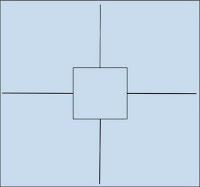 –Mandala. A basic diagram (popcycle mandala) is used consistently throughout KE to map and correlate correspondences across the layers and levels of the popcycle-mystory-wide image as Interface for the Stack of digital civilization. The diagram is not original, but is appropriated from various fourfold system templates. The diagram below registers the CATTt of a seminar documented in Ulmer’s blog,
–Mandala. A basic diagram (popcycle mandala) is used consistently throughout KE to map and correlate correspondences across the layers and levels of the popcycle-mystory-wide image as Interface for the Stack of digital civilization. The diagram is not original, but is appropriated from various fourfold system templates. The diagram below registers the CATTt of a seminar documented in Ulmer’s blog, 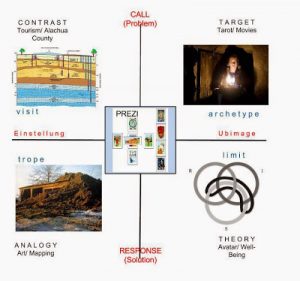
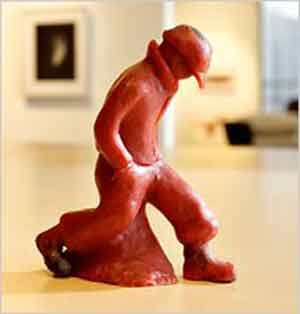
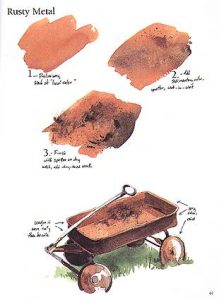 Family Discourse: Narrative
Family Discourse: Narrative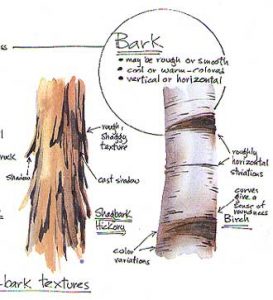 One version of the assignment proposed that this documentation be entirely visual, to foreground the pictorial image in the way that the Family entry foregrounded the verbal image. However, this distinction is arbitrary since in both cases there is supposed to be a balance of words and graphics (adapting the forms to the medium of the Web).
One version of the assignment proposed that this documentation be entirely visual, to foreground the pictorial image in the way that the Family entry foregrounded the verbal image. However, this distinction is arbitrary since in both cases there is supposed to be a balance of words and graphics (adapting the forms to the medium of the Web).